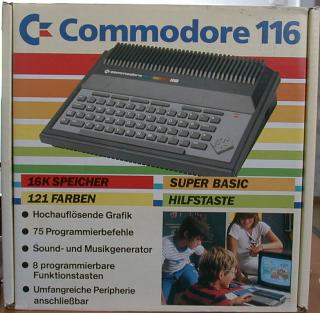
The picture to the left is a view of another box. This one was sold by Vobis in the old days. As usual, clicking on the picture will give a larger one, and clicking on the larger picture will give the picture in original size.
The C116 is a member of the Commodore 264 family of computers. There were several models available:
| Model | Description |
|---|---|
| C116 | 16k memory (12 k available for BASIC, 2k with graphics enabled), chiclet keys. |
| C16 | 16k memory (12 k available for BASIC, 2k with graphics enabled), case very similar to that of the old C64 ("breadbox"), dark gray color. |
| Plus/4 | 64k memory (60 k available for BASIC, 50k with graphics enabled), the shape of the case is similar to that of the C116, but somewhat larger and the Plus/4 has a "real" keyboard. Builtin software: Spreadsheet, word processor. Builtin ACIA (6551) but without real RS232 driver chips (Commodore did a lot things like this), so an external adapter providing the drivers was needed. |
There are some more models, but the three described above are the only ones actually marketed. It seems that the C116 was only sold in Europe.
All machines have the same hardware with some minor differences (6551 missing in C116/C16, different memory size and use of different memory chips, two additional ROMs in the Plus/4). Kernal and BASIC roms were identical, which means that an external ACIA chip added to the C16/C116 is supported by the kernal.
The 264 series had BASIC version 3.5 which is somewhat confusing, since it has more commands than the BASIC version of the old PETs (BASIC 4.0). BASIC 3.5 had all the disk commands of BASIC 4.0, but also support for graphic and sound. It is comparable to the BASIC 7.0 of the C128 but lacks the extensions for structured programming.
Graphic and sound was done by a highly integrated chip named "TED". Some of the software was called after this chip, for example the builtin machine language monitor was named "TEDMON". The TED supports text mode with 25 rows and 40 columns plus colors. Text mode is similar to that of the C64 but has additional 3 luminance bits for each color cell allowing 121 colors total (the odd number results from the fact that the eight luminances for black do not differ). Graphics mode was comparable to that of the C64 (320*200 high res and 160*200 multicolor mode) with the difference that the luminance bits do also work in this modes giving more total colors. The TED does not support sprites and the sound capabilities are far inferior to that of the C64.
BASIC 3.5 has support for high resolution graphic (320*200 pixel), but switching into graphics mode meaned that the available memory was decreased by 10K (8K for the bitmap and 2K for the video matrix), leaving just 2K for BASIC on the C16/C116. This made these models pretty useless without a memory extension. But as said above, the kernal is identical, so added memory (for example by replacing the memory chips and soldering some additional lines or by an expansion card) is supported by the kernal and by BASIC.
The 264 series had a 7501 CPU (8501 on later models) that was software compatible to the NMOS 6502 (what else would you expected from Commodore?). The CPU had a clock frequency of 1.78 MHz, so it is faster than the C64 or the old PETs, even if the CPU is stopped here and then by the TED.
On a machine with 64K RAM (a Plus/4 or an extended C16 or C116) the lower 32K were always RAM. The high 32K could be switched between RAM or ROM. When ROM is switched in, the range is subdivided into two 16K blocks, and in each of these blocks one out of four ROMs could be banked in. Unfortunately it is not possible to select a ROM in one of both 16K blocks and RAM in the other, a configuration that would give 48K of RAM plus one ROM (the kernal for example). This makes it somewhat difficult to write larger programs without banking.
The additional software of the Plus/4 was built into two ROMs that are banked in when the software is started.
There was a complete kernal disassembly available in a book sold from Markt&Technik in Germany (Commodore Sachbuch), it was useful and very well done.
Here is a rear view of the C116. From left to right: The power connector; a reset switch (yes, the C116 had one!); the connections for the serial IEEE bus and the datasette; expansion port; two joystick ports and the video output.

As you can see, the datasette and joystick connectors differ from the C64 and VIC 20 (which had the same joystick connectors as the Atari video consoles). This was a major problem, and there was only one joystick (model T-1341, sold under the Commodore brand) that had this connector. For all others, expensive adaptors were needed.
A first view into the case. The machine is heavily shielded inside, so the mainboard itself is mostly invisible for now. A closer look at the shielding reveals that it is bent somewhat (lower part, right half). This is because the machine has a memory expansion installed. The two replacement memory chips have additional sockets installed which did not fit exactly into the shielding case. The flat wire in the top left is the connection to the keyboard, which is mounted in the top of the case.
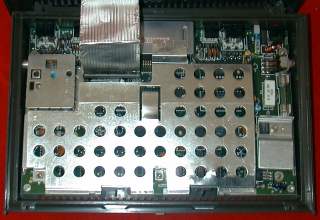
Last one: The following scans are from an advertisement sheet describing all members of the 264 family. The text is in german. Click on any of the images for a larger view.
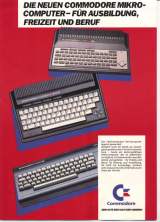 |
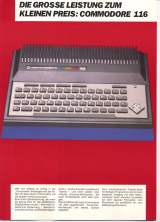 |
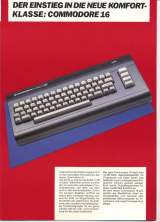 |
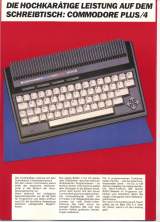 |
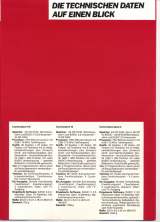 |
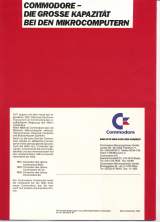 |